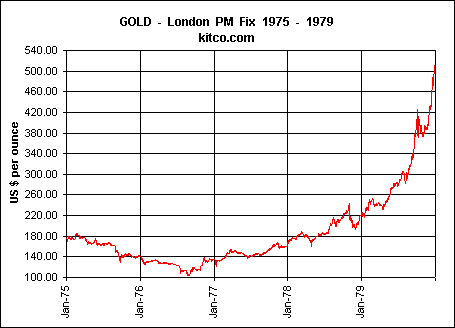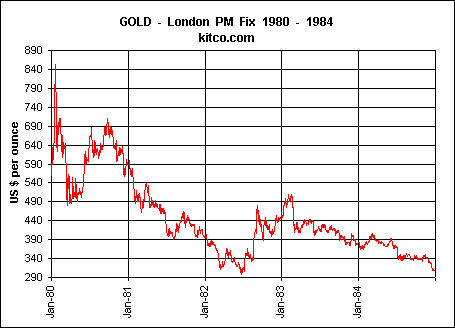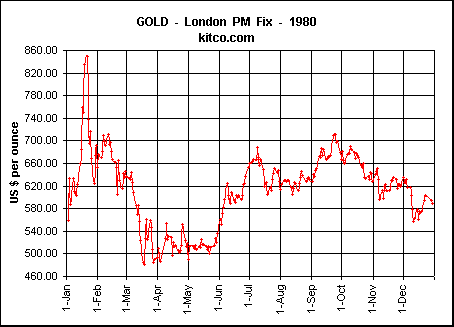“Reinstatement of the Dollar: a Blueprint” (Arthur Laffer, 1980)
June 9, 2013
Here’s something that Arthur Laffer (who was also working closely with Chuck Kadlec at the time) put out in February 1980. Of course, in 1980 the dollar had been declining in value for a decade, and, at the time of this paper, had just had a real crash which brought its value momentarily to $850/oz. Mercantilist “easy money” was a disaster. There was a lot of talk at the time of reinstating a gold standard system, which at the time had been gone only nine years, since August 15, 1971. Reagan was on his way to the presidency, winning in November 1980. Paul Volcker had been at the Federal Reserve since August 1979, and had begun a program of “hawkishness” i.e. an anti-inflationary, strong-dollar stance although this was quite confused, borrowing freely from Monetarist principles popular in the day, but in a rather flexible and ad-hoc way.
Click here to read “Reinstatement of the Dollar: a Blueprint” by Arthur Laffer



Let’s look at some of the more interesting bits of the paper.
Done improperly, dollar convertibility could cause egregious dislocations to the financial markets and the economy. If the price of gold were to be set too high, for example, inflation would continue to rise. Interest rates would reach new highs. If, on the other hand, the price of gold were set too low, the price level would fall, leading to deflationary pressures throughout the economy. Moreover, if the technical aspects of the program were defective, announcement of a return to dollar convertibility could create a speculative run on U.S. gold reserves that would abort the attempt to restore gold backing to the dollar.
NWE: Good stuff here. Laffer has a good understanding of how to find a decent parity value for a new gold standard system. There’s a tendency to make this problem bigger than it actually is. However, they were butting up against the Murray Rothbard types who figured that you would choose a new parity based on some ratio between base money outstanding and the amount of metal that happened to be in a vault. This was, alas, rather a stupid way to go about things, and tended to produce silly numbers that would have caused exactly the disasters that Laffer describes. Thus, Laffer was cautioning not only against the difficulty of the process itself — which really isn’t that great — but also the amazing state of ignorance of people at the time, especially other gold standard advocates but also the academic Keynesians and Monetarists, which indeed was quite dangerous. It was pretty lonely having even a whiff of a clue in those days.
Laffer also cautions about the operating mechanisms of such a new gold standard system. People’s understanding of proper operating systems was also pretty hopeless in those days. If nobody knows how to properly operate a gold standard system, the result would have been disaster.
A properly designed program should have as its initial goal the stabilization of prices generally at or near their current level. Secondly, the program must be credible and workable. And finally, it should be designed to protect the general economy from shocks to the gold market per se, disturbances that have nothing to do with monetary policy. Stated simply, a workable system of gold/dollar convertibility must not permit the economy to experience wrenching adjustments because of changes in gold. If shocks to the gold market do occur, any responsible system must permit the price of gold to do the adjusting. Therefore, safety valves must be included.
NWE: Laffer introduces the idea that gold itself might be unstable in value at some point, due to some gold-centric condition, and that the gold standard system he proposes could potentially accommodate this eventuality by adjusting in some way if necessary. This was probably a concession to fears of the time. I wonder what Laffer would consider a historical case of a major monetary event being caused by some gold-centric factor. I’ve never really found one. Some people in Laffer’s camp claim such things, but I find these claims are not based on much. Nevertheless, even if such a thing has never happened in the past (arguably), it could potentially happen in the future. It would be nice if Laffer didn’t put such compromises up front, but some concession for adjusting to the realities of the day is warranted.
The next several pages list Laffer’s plan for establishing a new gold/dollar parity value, and regarding operating mechanisms that follow. Basically, it amounts to:
1) establishing a three-month transition period
2) during this transition period, all open-market operations would cease, and the monetary base would be fixed.
3) the new gold parity would be the dollar/gold market price at the end of the three-month period
4) gold reserves would, over a period of time, be increased (if necessary) to cover 40% of base money outstanding
5) some rather complicated rules follow, regarding Fed actions. What it amounts to is: gold convertibility would be maintained. If gold reserves sank to a low level (indicating the dollar is weak compared to its gold parity), the monetary base would cease to grow. If reserves sank still further, the monetary base would be contracted. If gold inflows occurred (indicating a dollar that is strong compared to its gold parity), similar rules would follow that would require an increase in the monetary base.
This is a somewhat idiosyncratic but reasonable proposal. I think it would work. I also think you could develop a lot better proposals than this. I think it was, in many ways, a concession both to the political realities of the time, the rather pathetic state of intellectual understanding of the issues, and the level of ignorance that Laffer recognized among those that would be charged with making such a system work. I sense that Laffer’s understanding was quite good, and that he could have made many other proposals, if he felt that the situation warranted it.
January 29, 2012: Gold Standard Technical Operating Discussions 3: Automaticity Vs. Discretion
January 15, 2012: Gold Standard Technical Operating Discussions 2: More Variations
January 8, 2012: Some Gold Standand Technical Operating Discussions
The idea of having a three-month transition period, fixing the monetary base, and taking as a parity value the market’s dollar/gold ratio at the end of the period, is not a bad one. I probably would have gone for something like an average of the last ten trading days, not a single day’s price, which is awfully easy to manipulate. Nevertheless, it’s about the same overall. I’ve said that there are basically three ways that countries find a new gold/currency parity. Option #1: the old currency is totally destroyed in hyperinflation, and a new currency is introduced at any arbitrary parity value. Option #2: that a parity value around prevailing rates would be used. Option #3: that the parity value is returned to a pre-devaluation parity. There could be a variant of the third, which has never actually happened to my knowledge (at least in a deliberate fashion), but which would include a major increase in the value of the currency over an extended transition period (likely years), to some level like a ten-year moving average. I’ve suggested a one-year trailing moving average as a good variant of the second option (prevailing rates). It could be a three-month or six-month average. I think the outcome of Laffer’s proposal would be something like this, probably something in the neighborhood of a three-to-six-month trailing average. So, ultimately it is a variant, I would say, of Option #2. The three-month transition period is fairly short. It is nothing at all like the 14-year transition period between 1865 and reinstatement of the gold standard in 1879, a result of Congress’ decision to raise the value of the then-devalued dollar back to its prewar parity.
November 10, 2011: There Are Only Three Ways To Reinstate a Gold Standard
May 25, 2012: Why $1600 Is My Price At Which to Return to a Gold Standard System Today

What actually happened, via Volcker’s haphazard goofing around, was something like a variant of Option #3 — a return to a longer-term moving average level, over a period of years. The $350/oz. level that the dollar ultimately stabilized at during the 1980s and 1990s was something like a five-to-ten year moving average, and represented more than a doubling in value from the momentary low of $850/oz., and a near-doubling from the $612/oz. one-year trailing average in late 1980. The “transition period” in the Volcker case did take a number of years of wild swings between $700+ and $300 per ounce, before settling down mostly after Alan Greenspan took the helm in 1987. These wild swings produced all manner of difficulties, notably the 1982 recession which conincided with the dollar’s rise from a one-year moving average level of about $600 to $300/oz. momentarily in 1982 — a doubling of value. This was exactly what Laffer warned about when he said that if “the price of gold was … too low, the price level would fall, leading to deflationary pressures throughout the economy.” (It works that way whether the gold parity value is “set” at that level, or it just happens to go there in the context of a floating currency.) The whole thing was waaaaay more difficult than it could have been. I expect that Laffer’s proposal, if it had been implemented in 1980 soon after it was written, would have produced a parity probably around the six-month average of $600/oz., and that the 1982 recession could have been avoided as a result.
As for the operating mechanisms: The convertibility of gold and dollar would have kept the value of the dollar at the parity value, exactly (within the 0.7% “trading band” that Laffer explicitly describes). The Fed is given a certain amount of leeway to fool around, until things get out of hand too much as identified by large bullion flows, and then certain rules kick in. This was a political concession I think. These are rather silly operating mechanisms at face value, but a concession to allow the Fed to more or less operate as it had been on a day-to-day basis without rocking the boat too much. I think Laffer understood that, if the people at the Fed understood that certain rules would kick in if gold reserves either were depleted (showing an excessively low dollar value compared to the gold parity) or grew (showing an excessively high dollar value compared to the gold parity), then the Fed would actually learn to act to keep things in line before those triggers were hit. In other words, the Fed would naturally begin to conduct its daily operations in line with gold standard principles, just as the Bank of England did in the pre-1913 period, even as it operated as a central bank and had all kinds of daily open-market operations and lending activities.
Despite a rather high level of quirkiness here, the basic principles are clear: if the dollar’s value is sagging below its gold parity, resulting in bullion outflows, expansion of the monetary base would be halted, and eventually the monetary base would be contracted. The mechanism is clearly a direct adjustment of the monetary base, without any Monetarist M-figures, Keynesian interest-rate targets, or other such nonsense. The opposite occurs if the dollar is rising above its gold parity, resulting in inflows of gold bullion.
A lot of proposals, from many sources, are rather too quirky for my tastes. I think there is egotism involved. People all want to push “my special solution.” I personally like plain and generic, not-quirky and not-weird solutions.
Basically, I think Laffer’s proposals regarding the Fed and the methods of maintaining the gold standard system would work too. I think they were designed to accommodate the political realities and (extremely poor) economic understanding of the day. That in itself shows a level of sophistication — a willingness and ability to sculpt the proposal’s specifics to fit the perceived needs of the time. Personally, I am more of the teach-a-man-to-fish persuasion. I would rather just explain how to do things properly, rather than trying to build these strange contraptions around their ignorance. But, that is because I have the Internet, where you can learn to fish from websites like these. It was different then. Laffer could have written more books on the topic — he didn’t — but even book publishing was different then, and a lot more difficult. If you did write a book, and even self-publish it, how would you promote it without the Internet? Get a book review in a print publication? On a book about monetary policy? Also, like many in the Supply Side tradition of Classical monetary economics, Laffer had a Wall Street-related business to attend to, which certainly made him a lot more money than writing books on monetary theory and practice. Writing books is hard, hard work, and almost entirely unrewarded. The years and decades can slip by all too quickly, absorbed in the day-to-day of business, which is also a lot of fun and gives you a lot more positive feedback, and not only in monetary terms. Laffer is not the only one of the Supply Side crew of that era who didn’t pass on his knowledge in any kind of permanent form. Where are Robert Mundell’s great books? (Mundell did have a number of academic papers, and at some point I would like to go through them to find anything of interest.)
June 2, 2013: Merging the “Austrian” and “Supply Side” Traditions in Classical Monetary Economics
That is why I decided I had to write books — even if nobody cared. Fortunately for me, I didn’t have any big moneymaking Wall Street businesses to tend to at the time, but was instead happily unemployed when I wrote most of Gold: the Once and Future Money during three months in San Francisco, and three months in Eugene, Oregon, way back in 2000.
October 4, 2012: A Return to Stable Money Requires More Intellectual Gasoline
All in all, while I think Laffer’s specific proposals here a bit too idiosyncratic and reflect the political specifics of the time they were written, I sense a strong understanding of basic principles behind them — the kind of strong understanding that could generate all kinds of different, specific proposals in response to different political and economic realities of some other time and place. I also think the proposals would have basically worked, which is something that you can’t say of 90%+ of the gold standard proposals that have been floated over the years since 1980. A lot of people’s “big ideas” are just train wrecks waiting to happen. Now thirty-plus years later, people are still pathetically ignorant about these topics, although that has been slowly changing for the better.
It was such a small club in those days. They used to meet for dinner in a restaurant in Manhattan. Today, you can learn what they knew, and also a lot more, here on this website, without dinner reservations. My website statistics show that thousands of people do, every month. Over twenty thousand copies of my book have been sold in English, which is a big number for a book like this. Plus, it was published in four other languages. It was done via the Internet.

